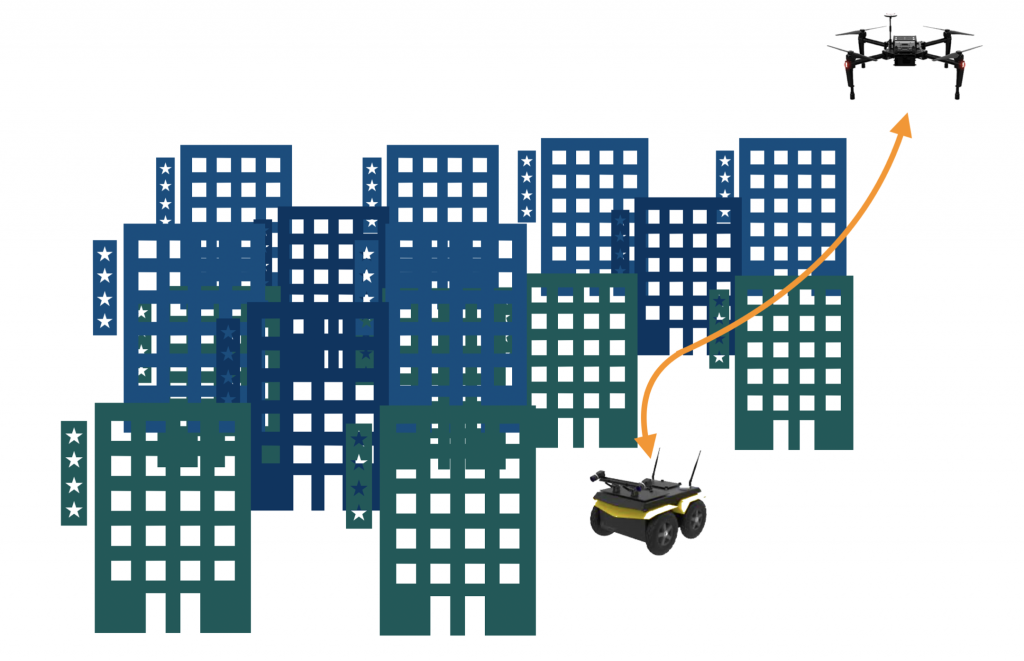One day in the future, Level 5 autonomous driving technology is already prevalent. Along with the development of e-commerce, delivery drivers can now get rid of the tedious driving events. However, one problem to be solved is that they still need to park the autonomous delivery truck in the street, and may sometimes block one side of the road. To address this problem, the United States Postal Service (USPS) decided to apply drone-truck collaborative delivery service.
Mr. Lin is the property manager at the SKY apartment in the Manhattan area, New York. One day, Lin received a participation inquiry from USPS to reconstruct the rooftop as the new package delivery site for the residents, for more safety and efficiency. Lin set up the building roof as the landing platform for the drone to receive packages; he also emptied the messy lobby of the building, which previously was flooded of packages. He emailed the residents about this change, including the instructions for using the new package management system.
Dr. Kim, one resident living in the SKY apartment, was about to return a shirt she bought online. Knowing the change in the package management system, she arrived at the top floor. She scanned the outgoing package information and handed the package to Mr. Lin.
The next morning, a USPS truck drove autonomously nearby. Mrs. Delson, the delivery specialist, received notification from the monitor to deploy a package onto a drone for delivery. She placed the package into the delivery cabinet, opened up the skylight, and placed the drone onto the landing platform. Since the platform is installed with magnets, she simply just needed to handle the drone near the landing platform, and the drone can be stuck in place easily. The truck stopped at a crossroad, waiting for the traffic light. Based on the built-in map of New York, combining with the LIDAR scan of the surroundings, the system automatically determined that it is a good time for the drone to take off. As the drone took off, the truck took Mrs. Delson away for the next site.
The drone flew up to the roof of Mr. Lin’s skyscraper. It landed onto the landing platform and dropped the package quickly. Before the drone was about to take off, the building’s package arrangement system sent a message to the drone, asking it to carry a returning package. Then, the drone turned off its motor. Mr. Lin walked close, put Dr. Kim’s package into the package box of the drone. He then approved the drone to take off. The drone, carrying the package, calculated its remaining battery reserve. Based on its calculation, the remaining battery range cannot support it to fly to the closest warehouse. It then sent a landing request to the cloud. Another autonomous delivery truck nearby, operated by Mrs. Karren, received the request and begin planning for landing. The current location of the truck is not optimal – it is close to the New York Stock Exchange, and the hanging flag from the building can block the drone from landing.

The truck found a good landing location from its map – at the crossroad of Madison Ave. and E. 78 St., which is broad and open to the sky. It planned a path to the crossroad and communicated with a drone about its plan. The drone agreed with the plan and began flying to the area. After both vehicles arrived, however, the truck was stuck within a flow of cars and could not slow down for the drone to land. The truck asked the drone to track and hold; it also activated several reserved waypoints for landing. As the truck followed the car flow for several blocks along E 78th St., it stopped at the traffic light crossing Lexington Avenue. It scanned the surroundings, assuring good landing factors, and approved landing request. The drone, which had also inspected the surroundings, agreed to land. The drone recognized the obvious rectangular feature of the landing platform and planned its path to the platform. After execution, the drone successfully lands on the truck before the traffic light turned green. The platform then began wireless charge to the drone, making it available for the next mission.